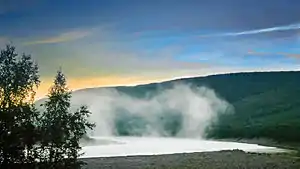| Tana Tenojoki / Deatnu / Tana älv | |
|---|---|
 View of the river | |
| Location | |
| Countries | |
| Regions | |
| Physical characteristics | |
| Source | Anarjohka-Karasjohka |
| • location | North of Karigasniemi, Norway-Finland border |
| • coordinates | 69°26′03″N 25°48′13″E / 69.43417°N 25.80361°E |
| • elevation | 125 m (410 ft) |
| Mouth | Tanafjorden |
• location | Tana Municipality, Troms og Finnmark, Norway |
• coordinates | 70°07′12″N 28°34′22″E / 70.12000°N 28.57278°E |
• elevation | 0 m (0 ft) |
| Length | 361 km (224 mi) |
| Basin size | 16,377 km2 (6,323 sq mi) |
| Discharge | |
| • average | 197 m3/s (7,000 cu ft/s) |
| Basin features | |
| River system | Karasjohka |
The Tana (Finnish: Teno [ˈteno] or Tenojoki; Northern Sami: Deatnu [ˈtea̯tnuː]; Norwegian: Tana/Tanaelva; Swedish: Tana älv) is a 361-kilometre (224 mi) long river in the Sápmi area of northern Fennoscandia. The river flows through Troms og Finnmark county, Norway and the Lapland region of Finland. The Sámi name means "Great River". The main tributaries of Tana are Anarjohka and Karasjohka.[1]
The Tana Valley is the core area for "the River-Sami Culture" in Finnmark; salmon fishing is central in regard to that culture.[2]
History: According to written sources since the 17th century, fishing has been a major livelihood for the Sami people in the river valley.[2]
Environmental concerns: erosion at the mouth of the river, in addition to extreme weather,[3] is making the mouth of the river wider but more shallow (as of the 2020s); there is a risk that salmon [or more salmon] during low tide will turn away (from the river) during approach to the river for spawning, according to a committee leader in Tana's municipal council.
The ocean has a (considerable) effect on the river, for c. 10 km from the mouth of the river.[3]
Geography

In its upper course, it runs for 256 km (159 mi) along the Finnish–Norwegian border, between the municipalities of Utsjoki, Finland, and Karasjok and Tana, Norway. The river is the fifth longest in Norway. The last 105 kilometres (65 mi) of the river run through the municipality of Tana in Norway. The river discharges into the Tanafjorden, one of the largest and most unspoiled river deltas in Europe. The delta is protected and is an important home to wetland birds. There are large deposits of sand in the delta that are exposed sandbars at low tide.[1]
Fishing
In 2022, authorities in Norway and in Finland will not permit salmon fishing (in the river).[4][5] In 2023, on Finland's side of the river, some[6] permits would allow fishing of humpback salmon - and the methods for that would be drift netting and[7] seine fishing.
In 2020, 18,600 kilograms (41,000 lb) was the annual total of salmon captured in the river.[5] Previously, in 2002, fishermen on the river captured an annual total of 99,546 kilograms (219,461 lb) salmon, with an average size of 4.5 kilograms (9.9 lb). The annual sea trout catch for that year on the river was 4,426 kilograms (9,758 lb). Both Finland and Norway regulate the fishing on the river.[1]
During the years when the authorities permit fishing, one can purchase a fishing permit (for angling). Some residents, can get a permit for fishing with barrier net; ['salmon-letter owner' or] laksebreveier use net for fishing.[8]
The Tana is well known for its excellent salmon fishery and is the most productive salmon river in Finland and Norway. The world's record for Atlantic salmon is held by a salmon caught on the Tana; it was 36 kilograms (79 lb) and was taken in 1929 by the Nils Mathis Walle.
In 2023, Norwegian authorities constructed a barrier with a trap that has sorted out hundreds[9] of humpback salmon (on some days), while allowing other fish to pass.[10][11][12] The installation is in the vicinity of Seidaholmen - and downstream of it. In August that year, media said that disassembly of the barrier had started.[13][14]
Transportation
The Tana Bridge (or Nybrua) was constructed in 2020, replacing the function of a neighboring bridge from 1948; its main span is 234 metres (768 ft).
The Sami Bridge at Utsjoki was constructed in 1993. The European route E6 highway follows the western shoreline of the river for most of the length of the river.
In winter, there are usually two ice roads that are in use from December to April. These roads are located near Rustefjelbma and near Polmak and have a weight limit of 2 tonnes (2.0 long tons; 2.2 short tons), but few other limitations.
References
- 1 2 3 Store norske leksikon. "Tanaelva" (in Norwegian). Retrieved 2013-03-21.
- 1 2 Aage Solbakk. BUOĐĐU - Utviklingen av garnfisket i Tanavassdraget - Med vekt på perioden 1984-2015. https://deatnu.net/wp-content/uploads/2021/03/Utviklingen-av-garnfisket-i-Tanavassdraget.pdf. Page 3. DeanuInstituhtta. Retrieved 2023-05-22
- 1 2 https://www.sagat.no/debatt/til-lakseelskere-i-tana-og-karasjok/19.42166. Sagat.no. Retrieved 2023-01-08
- ↑ https://www.nrk.no/vestland/no-startar-laksefisket-_-i-elvane-som-ikkje-er-_tomme_-1.15985725. NRK. Retrieved 31 May 2022
- 1 2 "Stopp i laksefisket i Tanavassdraget – overfiske får skylda". 7 April 2021.
- ↑ https://www.sagat.no/debatt/uttak-av-pukkellaks-pa-norsk-og-finsk-side-av-tanaelva/19.38954. Sagat.no. Retrieved 2023-06-28
- ↑ https://www.sagat.no/far-bruke-drivgarn-og-not-pa-finsk-side/19.38625. Ságat.no. Retrieved 2023-06-17
- ↑ https://www.ifinnmarkdebatten.no/til-lakseelskere-i-tana-og-karasjok-gratulerer-med-dagen/o/5-81-1946752. iFinnmark.no. Retrieved 2024-01-10
- ↑ ['took 467 humpback salmon on Tuesday'] https://www.sagat.no/nyheter/tok-467-pukkellaks-tirsdag/19.39208. Sagat.no. Retrieved 2023-07-12
- ↑ https://www.nrk.no/sapmi/tanaelva_-fella-skal-ta-pukkellaks_-men-har-ikke-lyktes-enna-1.16469743. NRK.no. Retrieved 2023-07-04
- ↑ https://www.sagat.no/nyheter/na-fanger-fella-ved-sieidd-suolu/19.39002. Sagat.no. Retrieved 2023-06-30
- ↑ https://www.sagat.no/. Sagat.no. Retrieved 2023-06-24
- ↑ https://yle.fi/a/74-20045450. Yle.fi. Retrieved 2023-08-16
- ↑ https://www.sagat.no/nyheter/na-demonteres-fella-fra-tanaelva/19.39784. Sagat.no. Retrieved 2023-08-16
External links
![]() Media related to Tana River (Fennoscandia) at Wikimedia Commons
Media related to Tana River (Fennoscandia) at Wikimedia Commons
- Historiker: – En stor skandale innen naturforvaltning [Historian: – A great scandal in regard to conservation of nature] (10 April 2021) NRK
- Aage Solbakk. "LuossaLaksSalmon". https://deatnu.net/luossalakssalmon/. DeanuInstituhtta. Retrieved 2023-05-22
- Angling in Tana river